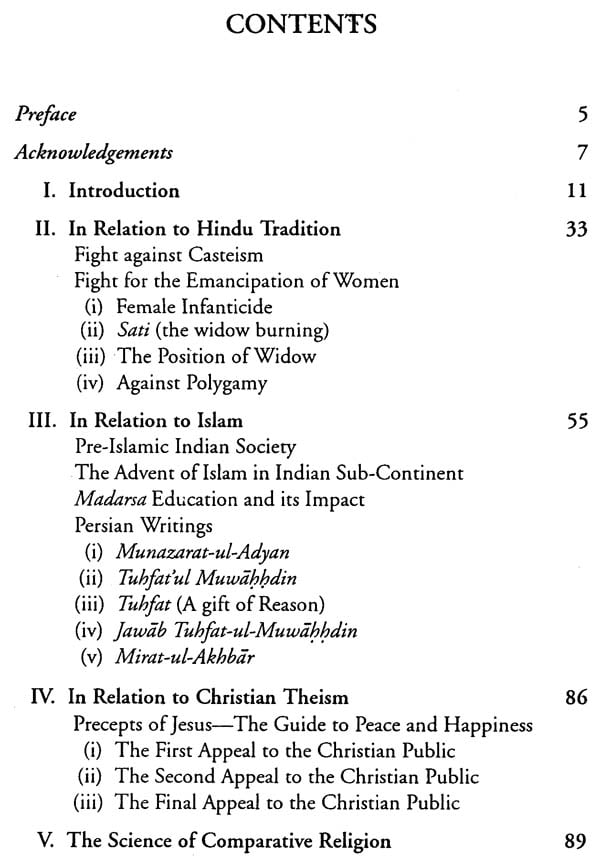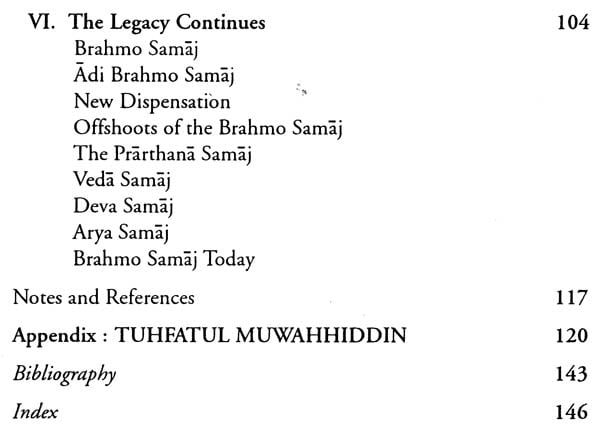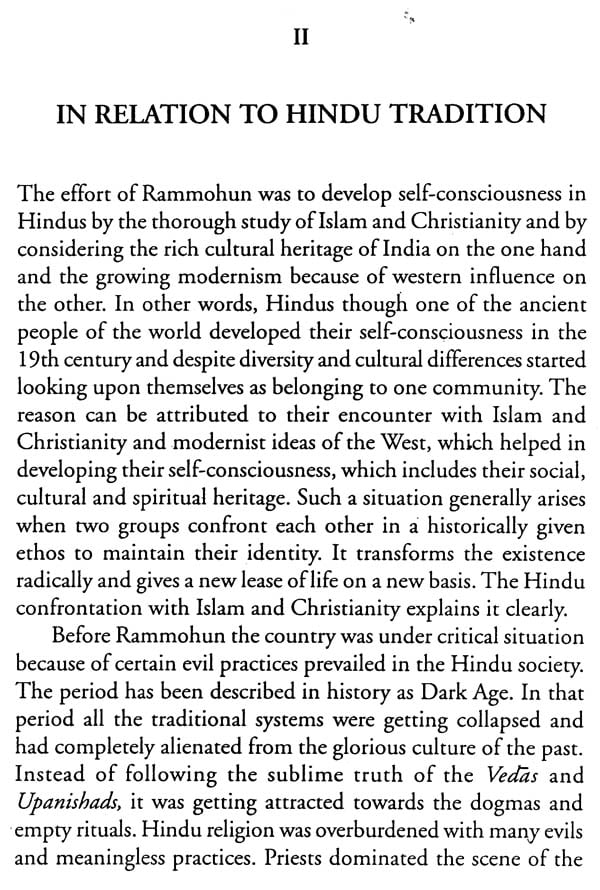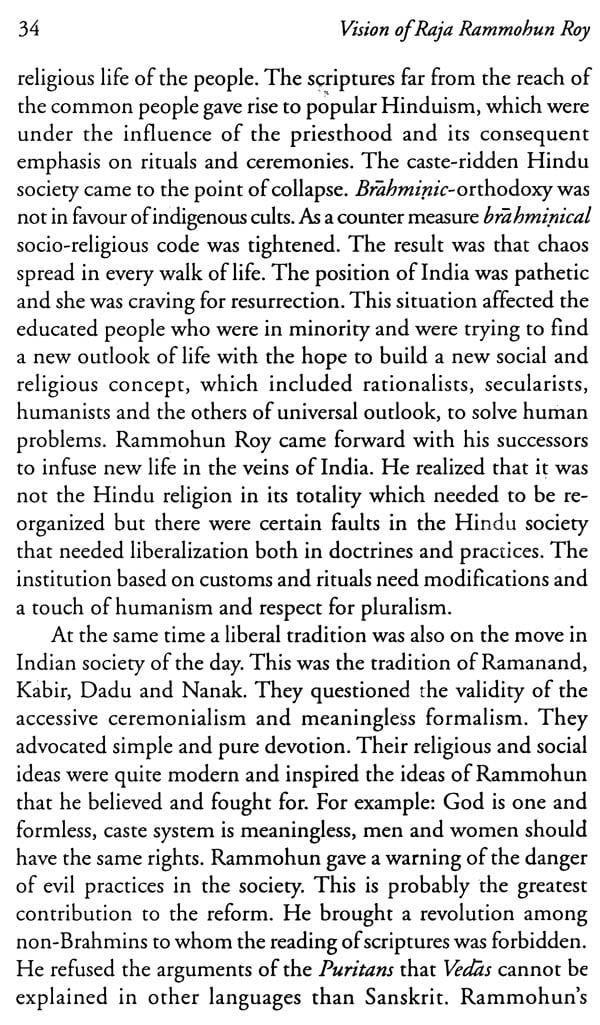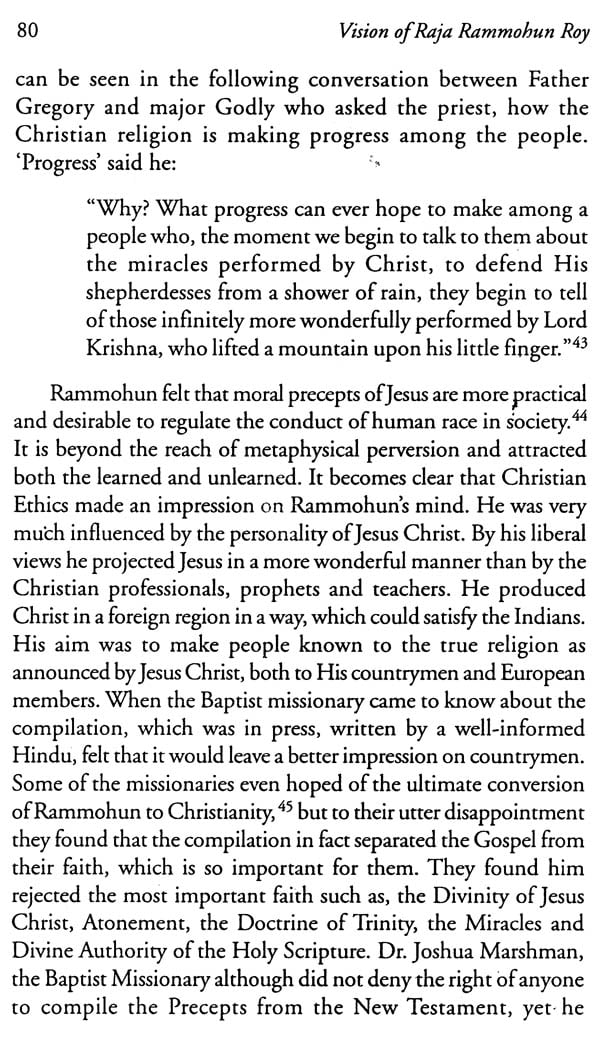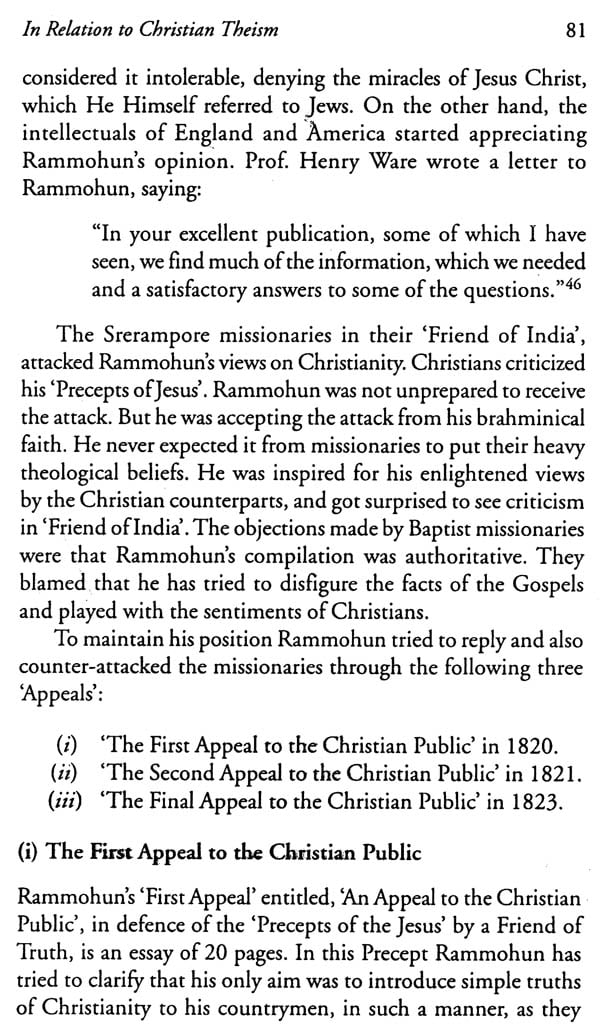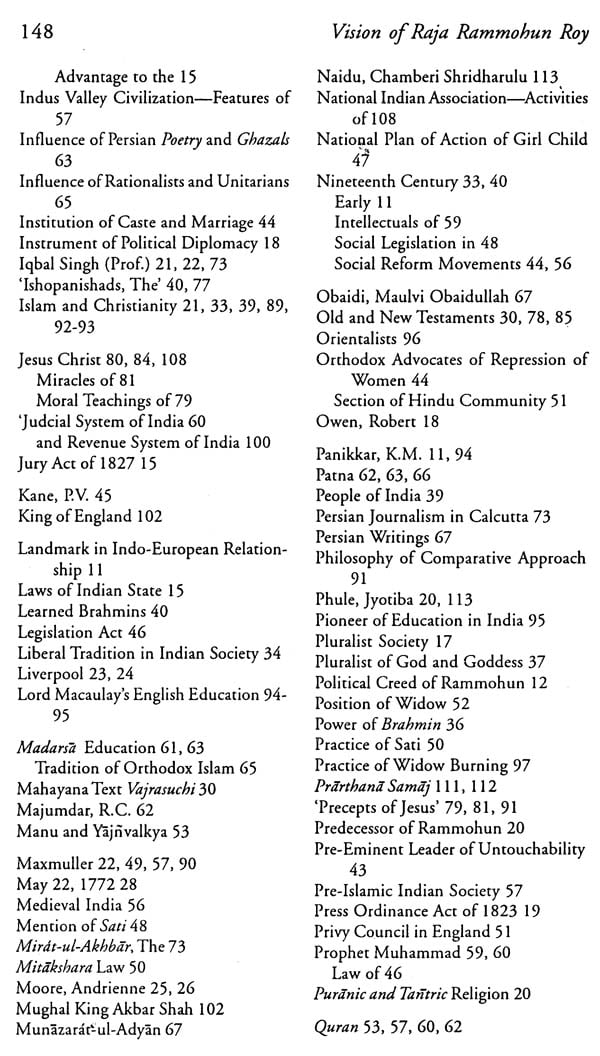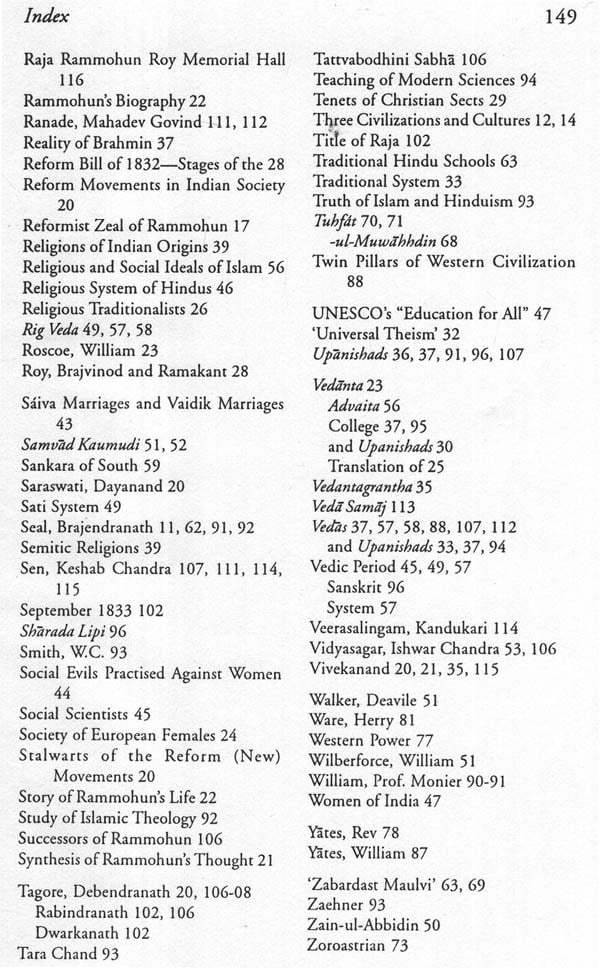
Vision of Raja Rammohun Roy
Book Specification
| Item Code: | NAW123 |
| Author: | Reeta Bagchi |
| Publisher: | KANISHKA PUBLISHERS |
| Language: | English |
| Edition: | 2004 |
| ISBN: | 9788173916588 |
| Pages: | 150 (5 B/W Illustrations) |
| Cover: | HARDCOVER |
| Other Details | 8.50 X 5.50 inch |
| Weight | 310 gm |
Book Description
As class struggle grew more acute in the late 18th and early 19th century, an ideological trend of enlighteners, socio-religious reformers and thinkers took shape of which the most outstanding figure was Rammohum Roy (1772-1 833). Rammohun along with his colleagues was the precursor of the Indian movement of bourgeois enlighteners of the nineteenth century. He is known for his struggle against India’s feudal backwardness, scholasticism and the gap between theoretical ideas and life. He spent his youth in study and spiritual quest. He received mastery over different languages to study the world literature in original. Apart from the study of Islam, Christianity, Buddhism and Hindu philosophy, he studied the works of European philosophers and sociologists, in particular of Bacon and Bentham. He personally met many West European thinkers. He was attracted towards French enlighteners and was interested in the history of the French Revolution and other revolutionary movements took place in Spain, Italy and Germany. He had faith in its ultimate triumph. In characterizing Rammohun’s encyclopedic erudition Romain Rolland wrote that he embraced a range of knowledge from Himalayan mythology to the scientific disciplines of modern Europe. He was a great writer in Sanskrit, Benge Arabic, Persian and English. He is known as the-father of the Bengali prose and first in the field of Persian journalism in Calcutta by writing a Persian book entitled, ‘Tuhfat ulmuwahhidin’. He sowed the seeds of his thoughts in Bengal, from where it spread all over India. Humanist thinkers like Gandhi, Nehru, Tagore, M.N. Roy were influenced by him. He introduced the education built on European model and based on the modern natural sciences. He was one of the founders of Indian National Press and published several papers to spread the views of the enlighteners. He fought for the freedom of press and freedom of expression. He was critical to tradition and Hindu religious practices, caste system and gender discrimination which had divided the society into isolated groups differing in the origin and status of their members. He founded Brahmo Samaj, which was open to everyone irrespective of his or her colour, convictions, caste, nationality and religion. He was a great figure In Indian culture, the pride of Indian people and the entire progressive mind throughout the world. Rammohun and his followers did their best to make India part of the global civilization by bringing her out of the age old stagnation and lifting her to the level of the progressive countries of the world.
Reeta Bagchi, Senior Faculty Member, Islamic Studies and Social Sciences, Hamdard University, New Delhi. Teaching Comparative Religion in Post Graduation and working on research projects on Comparative Studies. Specialization in Indian Philosophy and Comparative Religion. Member, Advisory Committee of various educational institutions and practically engaged in social awareness programmes. Attended National and International conferences in India and Abroad. Apart from many research papers, review of books in reputed journals, book chapters, the published work Gandhi and Ambedkar on Islam and Indian Muslims.
Rammohun Roy came into the picture of Indian history in early nineteenth century. His aim was to introduce new ideas to raise the country to the heights of civilization. For this he combined the progressive outlook of eastern thought and the scientific outlook of western vision. His understanding was based on rationalistic and humanistic philosophy of the west which helped in developing his universal outlook and bonds of union with the people all over the world. His interpretations of religious texts appeared in a new way to the masses and exercised a great influence on the mind and thought of contemporary India. He realized contradictions, confusions, and communal feuds in society, social suffering and injustice, due to dogmatism and fanaticism, which had developed on national level. Rammohun rose above the limitations of sects and rival communities with the message of humanism to fulfil the need of social readjustment at the time, when these negative forces were threatening our very existence. He strongly advocated racial equality in India and all over the world, which has not yet been attained. For the slavery he fought against, has returned in the form of wage slavery under the guise of economic disparity and forced labour, even the child labour. Also there existed religious intolerance and hatred towards people of other faiths. For the great causes for which he stood so boldly, it seems backward current have often proved too rapid instead of the forward progress.
He tried to achieve a creative understanding of different faiths, the basic concept behind the worldwide interfaith movement today. His ideas were based on ‘dialogue’. He never hesitated to learn from any other traditions than his own. He thoroughly studied different religious traditions in original: like Islam, Christianity, Buddhism and other religions and he conceptualized anew universal outlook based on dialogue. His dialogical Hinduism gavehimthe ~ courage to raise his voice of dissent agaiftst many ugly practices he saw in institutionalized or Brahmnical Hinduism—Untouchability, women’s oppression etc. He primarily learnt also from Hindu scriptures about the principle of unity of all life. He delivered his message of wholehearted love for humanity that runs through his works having a definite purpose. He introduced a worldview and a radical faith based on our common social customs. He had a true vision of Internationalism. These universal ideas had been nurtured over centuries in India. Now, as violence has become the only mode of articulation in the present conflicting situation, the possibility of dialogical communication has less importance in our social communities today. It is dialogue, which is the primary requisite for the existence of a meaningful ethos in which people understand each other and give their consent to a shared practice.
He can be said the originator of non-violent approach which he followed throughout his life. His name is inseparably connected with the great moral revolution, which he tried to bring with the weapon of education. It is time for us to recognize those values illustrated in the variety of the activities of - Rammohun, a unique figure in the history of India. His thoughts and powerful insights have greater utility today in 21st century, at a time when there is broader appreciation of human rights. Rammohun made an effort to synthesize the multilingual, multi- racial and multi-religious country. His Brahmo Samaj (society) was the practical example of the theoretical understanding. It has a great significance and relevance.
It is difficult to define the particular aim of Brahmo Samaj, as ‘it has worked in every field of life. Some consider it as protest against Hindu orthodoxy, others praise it as a social reform. Some criticize it as a sublimated form of Christianity. But to realize the root or the whole truth it is necessary to see the role it has played ‘n different areas in order to reach the conclusive reality.
In the early 19th century India was emerging into a modern nation. The impact of western thought brought about cultural and social revival that was initiated by men of modern outlook though inherent in the Indian tradition. One of them was Rammohun Roy, who has been ranked by Brajendranath Seal as one of the most eminent Encyclopaedists with world figures like Bacon, Voltaire and Volney. He has been described as a precursor, an archetype, and a prophet of coming humanity. K.M. Panikkar in his, Survey of Indian History, did not even hesitate to see and proclaim, a sort of parallelism in reverse, between Vasco-de-Gama’s arrival in India (1498) and Rammohun’s journey to Britain (1830) as landmark in Indo- European relationship.
Rammohun is known for his life and activities, which revolved around secularism, humanism and universalism. With the spirit of catholic reformism, he worked in various fields viz. political, social, economic, educational, legal and religious. His activities spread over a wide field, and we recall with amazement the breadth of vision, which he had at a time more than 150 years ago, is rare even today. In the light of India’s cultural dialectics during the past three centuries and the process of westernization that have gone along with it, he is considered to have been, even in the context of his own time, a champion of the lost noble causes. He is called ‘Father of Modern India’, for his social and religious movements. He had a rare dynamism to oppose the static condition of the then society. He strongly opposed traditional Hindu religious practices and rituals recommended by the Dharma Sastras (religious scriptures). He elevated people against the crude practice of Sat: (widow burning), female infanticide and other issues that caused suffering and injustice towards women. He founded the monotheistic faith that rejects the rigid caste system, helped in breaking the barriers of social and religious exclusiveness to bring together the different communities. His admiration of Sankaracharya, Prophet Mohammed and Jesus Christ developed a composite character in him. The three civilizations and cultures, z.e., Hindu, Muslim and European had laid a foundation of his work. He stressed upon the urgent need of unity, a need of concord between different people and acted as a great unifier, which is a greater need today to understand each other in 21st century.
He was a great admirer of ancient Indian culture and civilization and translated many Vedic and Vedantic texts in Bengali and English to represent the glory of Indian civilization to the world. He also realized that human civilization could not lie in isolation but the inter-dependence of individuals as well as of nations is necessary in all spheres of thought and activity. He wanted to break the cultural isolation of world and community at large. That is why he made an effort to synthesize and harmonize different strands of culture and civilization for the promotion of common good, peace and unity, all over the world.
**Contents and Sample Pages**
